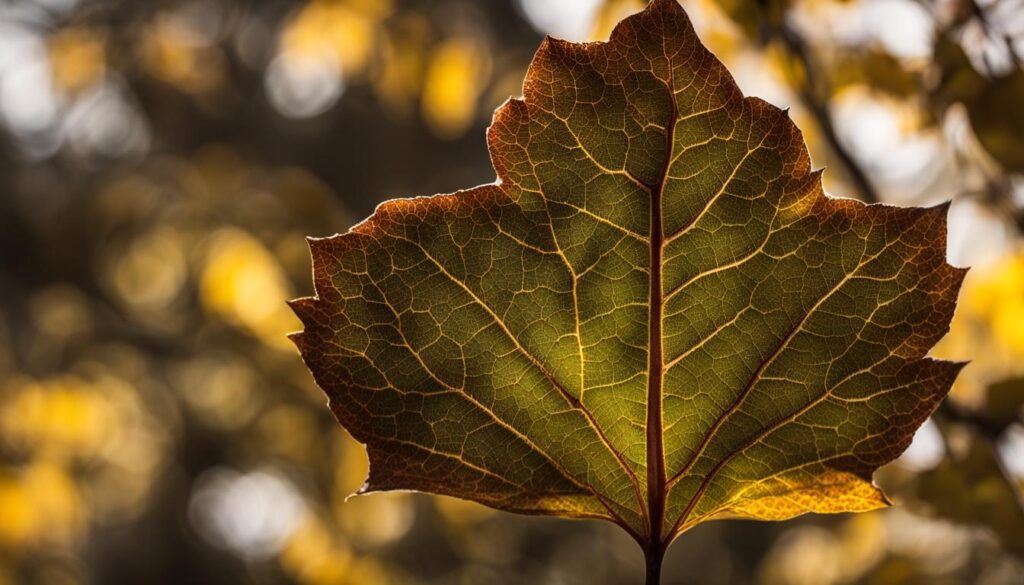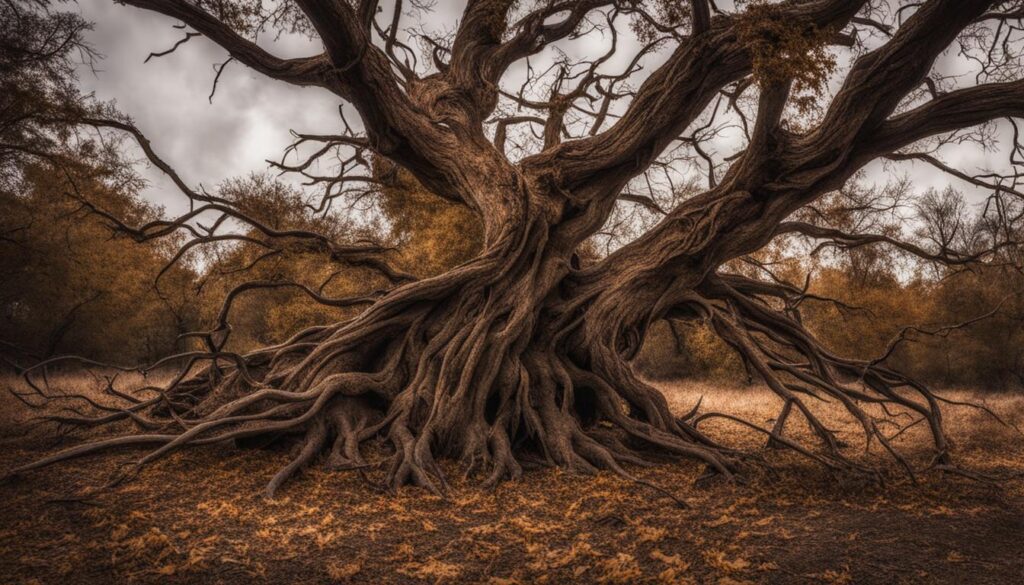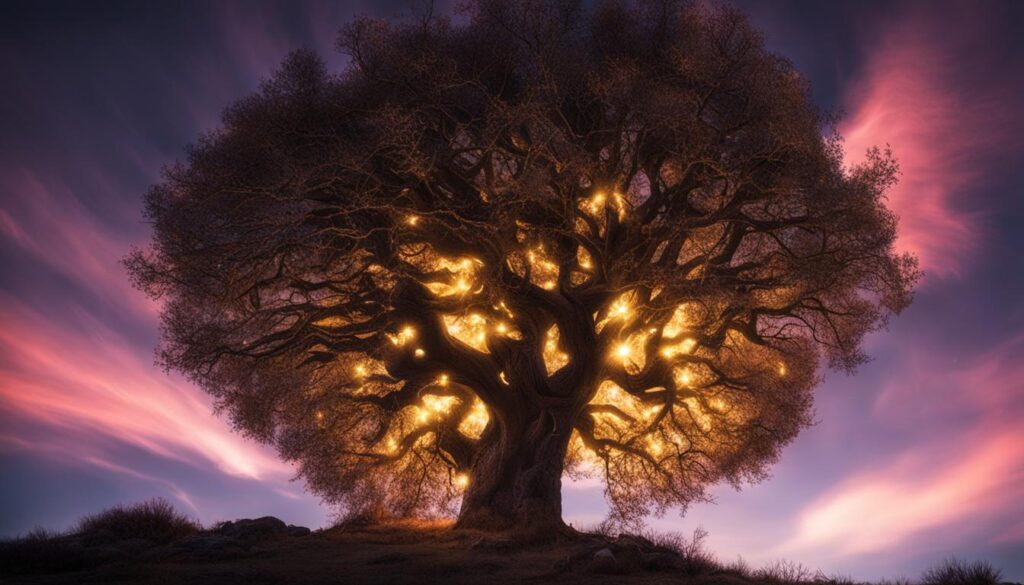Hello, I’m here to provide you with important information about bacterial leaf scorch, a serious tree disease that affects various shade trees. Bacterial leaf scorch, caused by the bacterium Xylella fastidiosa, can have detrimental effects on tree health and is a significant concern for plant enthusiasts and arborists alike. In this article, we will explore the symptoms, causes, management, and prevention methods for this tree disease.
Key Takeaways:
- Bacterial leaf scorch is a tree disease caused by Xylella fastidiosa that affects a variety of shade trees.
- Symptoms include scorched areas on the leaves, reduced growth, dieback, and browning of the leaves.
- The disease is spread by insect vectors and can be mistaken for drought or other environmental stress.
- Currently, there are no treatments available for bacterial leaf scorch, but management practices can help slow its progression.
- Proper tree care, prompt pruning of infected branches, and cultural practices to promote tree vigor can aid in managing the disease.
Symptoms of Bacterial Leaf Scorch
The symptoms of bacterial leaf scorch can vary depending on the tree species affected. However, one of the most common signs is the presence of scorched areas on the leaves with a yellow halo. These areas may appear as irregular marginal browning on the interior leaves of the lower branches, typically in mid to late summer.
As the disease progresses, the symptoms move through the crown of the tree, starting with the lower branches and older interior leaves. Severe infections can lead to reduced growth and dieback, further compromising the health of the tree.
It is important to differentiate bacterial leaf scorch symptoms from those caused by drought. While bacterial leaf scorch primarily affects the lower branches and older leaves, drought scorch symptoms typically appear near the upper branches and younger leaves.
Causes and Spread of Bacterial Leaf Scorch
Bacterial leaf scorch is a tree disease caused by a bacterium known as Xylella fastidiosa. This bacterial infection is primarily spread by insect vectors, including sharpshooters, treehoppers, and spittlebugs. Once these insects come into contact with an infected tree, they can carry the bacterium to other trees, facilitating the spread of bacterial leaf scorch.
Upon entering a tree, the Xylella fastidiosa bacterium multiplies within the xylem, which is responsible for conducting water and nutrients. This multiplication process blocks the flow of water in the tree, leading to the characteristic symptoms of leaf scorch.
The spread of bacterial leaf scorch is not limited to tree-to-tree transmission through insect vectors. The disease can also be present in alternative hosts such as shrubs, grasses, and weeds. These alternative hosts can serve as reservoirs for the bacterium and further contribute to the spread of bacterial leaf scorch.
To accurately diagnose bacterial leaf scorch, laboratory analysis is necessary. Through laboratory testing, experts can identify the presence of the bacterium and confirm the disease’s specific cause.
Factors Contributing to the Spread of Bacterial Leaf Scorch
| Factor | Description |
|---|---|
| Sharpshooters | Insect vector known to transmit the bacterium between trees. |
| Treehoppers | Insect vector capable of spreading the bacterium in tree populations. |
| Spittlebugs | Insect vector that aids in the transmission of bacterial leaf scorch. |
| Alternative Hosts | Shrubs, grasses, and weeds that can harbor the bacterium and contribute to its spread. |
Tree Species Affected by Bacterial Leaf Scorch
Bacterial leaf scorch is a tree disease that can affect a wide range of tree species, particularly shade trees commonly found in landscapes. Some of the tree species susceptible to this disease include oak, maple, sycamore, elm, catalpa, hackberry, ginkgo, mulberry, and sweetgum. These trees play a vital role in providing shade and enhancing the aesthetic appeal of our surroundings. Unfortunately, bacterial leaf scorch poses a threat to their health and survival.
Bacterial infections in plants have also been identified in other tree species such as ash, boxelder, dogwood, and lilac. It is important to note that as research continues, additional hosts and alternative hosts of bacterial leaf scorch are being identified, further expanding the list of vulnerable tree species.
Recognizing the susceptible tree species is crucial for early detection and implementing appropriate management strategies. By understanding which trees are most at risk, tree care professionals and arborists can take proactive measures to prevent and manage the spread of bacterial leaf scorch.
Management and Treatment of Bacterial Leaf Scorch
Currently, there are no treatments available to cure bacterial leaf scorch. However, infected trees can be managed by promptly pruning out symptomatic branches and dead wood. Antibiotic trunk injections administered by a licensed arborist have shown promise in relieving symptoms, but they do not provide a cure. It is important to note that tree replacement may be necessary if the disease progresses and poses a safety hazard.
When dealing with bacterial leaf scorch, it is crucial to prioritize the health and safety of the affected trees. Prompt pruning of symptomatic branches and dead wood can help minimize the spread of the disease within the tree and reduce the risk of further infection. This pruning should be done by a professional arborist to ensure proper techniques and minimize stress on the tree.
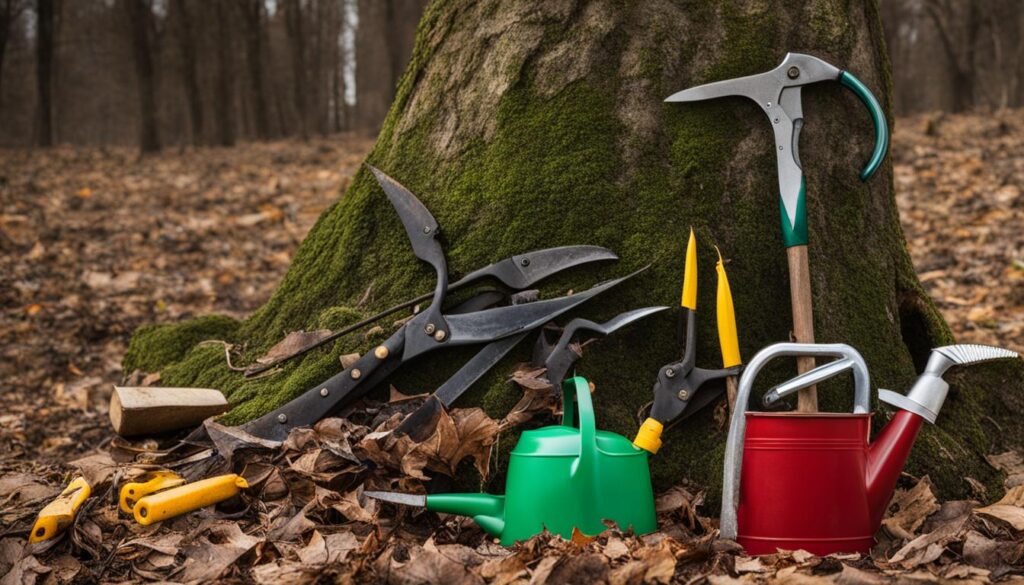

In addition to pruning, another management option to consider is antibiotic trunk injections. Administered by a licensed arborist, these injections can help alleviate symptoms and prolong the tree’s life. However, it is important to note that this treatment does not provide a cure for bacterial leaf scorch. Instead, it aims to provide temporary relief and improve the tree’s overall health.
While management strategies can help control the impact of bacterial leaf scorch, it is important to be realistic about the limitations of treatment options. Currently, there is no known cure for this disease. Therefore, it may be necessary to assess the long-term viability of infected trees and consider tree replacement if the disease progresses and threatens the safety of the surrounding area.
Tree replacement should be done with careful consideration of the tree species and its resistance to bacterial leaf scorch. By choosing non-susceptible replacement trees and planting them strategically, you can help prevent the spread of the disease and maintain a healthy tree population in the affected area.
Diagnosis of Bacterial Leaf Scorch
While the symptoms of bacterial leaf scorch may seem distinctive, proper diagnosis can only be determined through laboratory analysis. Leaf tissue and petioles can be tested for the presence of the bacterium in a laboratory assay. It is important to submit samples to a diagnostic lab for accurate diagnosis. Other diseases and abiotic factors can cause similar symptoms, so a positive diagnosis is crucial for effective management.
When suspecting bacterial leaf scorch, it is essential to consult with a professional arborist or a plant diagnostic lab to assess the situation accurately. This ensures that the correct diagnosis is made before moving forward with any treatments or management practices. Laboratory analysis provides the most reliable results, as it distinguishes bacterial infections from other potential causes of leaf scorch.
Leaf tissue and petioles should be collected from symptomatic branches or leaves exhibiting scorched areas. These samples can be placed in sterile plastic bags or containers and labeled appropriately with the tree species, the date, and the location. The samples should be sent to a diagnostic lab as soon as possible to ensure the integrity of the samples and to obtain timely results.
Upon receiving the samples, the diagnostic lab will conduct laboratory assays to test for the presence of the bacterium Xylella fastidiosa. These assays may include polymerase chain reaction (PCR) tests or serological tests. PCR tests detect the DNA of the bacterium, while serological tests detect specific proteins produced by the bacterium. The lab technicians will analyze the results and provide a diagnosis based on their findings.
Obtaining an accurate diagnosis of bacterial leaf scorch is crucial for effective management and prevention. Once a positive diagnosis is confirmed, appropriate measures can be taken to minimize the impact of the disease and prevent its spread to other trees. It is important to remember that bacterial leaf scorch is a serious tree disease that requires professional expertise and proper diagnosis for successful management.
Cultural Practices to Promote Tree Vigor
In order to maintain tree health and slow the decline caused by bacterial leaf scorch, it is essential to follow specific cultural practices. These practices can help improve tree vigor and potentially mitigate the progression of tree diseases.
Pruning Infected Branches
Regular pruning of infected branches is crucial to prevent the spread of bacterial leaf scorch. By removing affected branches, the disease can be contained and the overall health of the tree can be preserved. It is important to properly prune the tree to minimize any potential damage and promote new growth.
Supplemental Irrigation during Dry Periods
In times of drought or dry periods, providing supplemental irrigation to the tree can help maintain its vigor. Watering deeply and infrequently can encourage the development of a robust root system, enabling the tree to better withstand stress and resist diseases. It is recommended to water early in the morning or late in the evening to minimize water loss through evaporation.
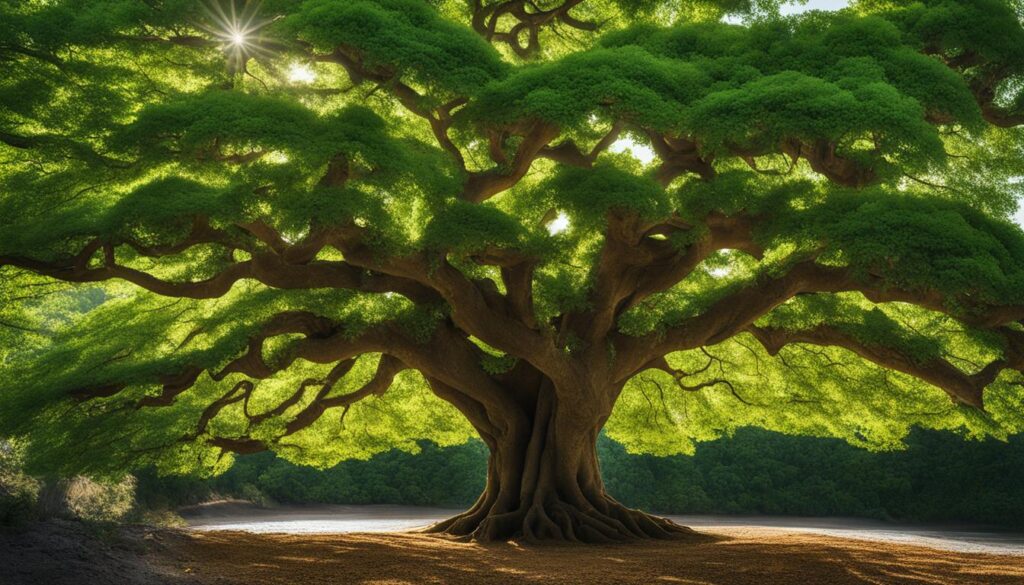

Applying Mulch to Conserve Soil Moisture
Applying mulch around the base of the tree can help conserve soil moisture, regulate soil temperature, and inhibit weed growth. A layer of organic mulch, such as wood chips or bark, should be spread around the root zone of the tree, leaving a gap around the trunk to prevent rot. This mulch layer helps retain moisture, reducing the tree’s water stress and promoting overall tree health.
Fertilizing Based on Soil Test Results
Proper fertilization based on soil test results is essential for maintaining tree health. Testing the soil can determine the nutrient deficiencies or imbalances that may be affecting the tree. By applying the appropriate fertilizer, the tree can receive the necessary nutrients to improve its vigor and resilience against diseases. It is important to follow the recommended application rates and timing to avoid over-fertilization, which can be detrimental to the tree’s health.
By implementing these cultural practices, such as pruning infected branches, providing supplemental irrigation, applying mulch, and fertilizing based on soil test results, you can promote tree vigor and enhance its overall health. These practices can help minimize the impact of bacterial leaf scorch and other tree diseases, allowing your trees to thrive for years to come.
Tree Replacement and Removal
In cases where bacterial leaf scorch progresses and poses a safety hazard, tree removal may be necessary. It is essential to prioritize the safety of individuals and property when making this decision. Consulting with a professional arborist is highly recommended to ensure safe and proper removal.
After removing the infected tree, it is important to consider tree replacement to maintain a healthy tree population in the area. Planting non-susceptible replacement trees is crucial to prevent the spread of diseases and preserve the beauty of the landscape.
When selecting replacement trees, it is advisable to choose native species or trees that are known to thrive in the specific area. Native trees are better adapted to local environmental conditions and are often more resistant to diseases and pests. By planting trees well-suited for the region, you can help ensure their long-term health and resilience.
Conclusion
Bacterial leaf scorch is a serious tree disease that can have devastating effects on shade trees, leading to leaf scorch symptoms and potentially causing tree decline. While there is no cure for the disease, proper management practices can help slow its progression and promote tree vigor. It is crucial to implement prompt pruning of infected branches, follow cultural practices to enhance tree health, and consider tree replacement in affected areas to effectively manage bacterial leaf scorch.
By promptly removing infected branches, you can reduce the spread of the disease and mitigate its impact on tree health. Cultural practices such as supplemental irrigation during dry periods, mulching to conserve soil moisture, and fertilizing based on soil test results can also contribute to maintaining tree vigor and strengthening their ability to withstand bacterial infections.
Furthermore, in cases where bacterial leaf scorch progresses and poses a safety hazard, it may be necessary to consider tree removal. When removing infected trees, it is important to consult with professional arborists who have the expertise to handle the task safely and effectively.
To ensure the long-term health and vitality of your trees, consulting with a professional arborist is essential. They can provide accurate diagnosis, guidance on tree care, and tailor management strategies specific to your tree’s needs. Protecting tree health and preventing the spread of bacterial infections in plants is crucial for maintaining a thriving landscape and preserving our natural ecosystem.
FAQ
What are the symptoms of bacterial leaf scorch?
The symptoms of bacterial leaf scorch include scorched areas on the leaves with a yellow halo, reduced growth, and dieback. These symptoms can be mistaken for drought or other environmental stress.
What causes and spreads bacterial leaf scorch?
Bacterial leaf scorch is caused by a bacterium called Xylella fastidiosa, which is spread by insect vectors such as sharpshooters, treehoppers, and spittlebugs. The bacterium grows in the plant’s vascular tissue and blocks water movement from the roots.
Which tree species are affected by bacterial leaf scorch?
Bacterial leaf scorch can infect a variety of shade trees, including elm, catalpa, hackberry, ginkgo, oak, sycamore, maple, mulberry, and sweetgum. Other species such as ash, boxelder, dogwood, and lilac have also been identified as hosts.
Is there a treatment for bacterial leaf scorch?
Currently, there are no treatments available to cure bacterial leaf scorch. However, infected trees can be managed by promptly pruning out symptomatic branches and dead wood. Antibiotic trunk injections administered by a licensed arborist have shown promise in relieving symptoms, but they do not provide a cure.
How is bacterial leaf scorch diagnosed?
Proper diagnosis of bacterial leaf scorch can only be determined through laboratory analysis. Leaf tissue and petioles can be tested for the presence of the bacterium in a laboratory assay. It is important to submit samples to a diagnostic lab for accurate diagnosis.
What cultural practices can promote tree vigor and health?
To promote tree vigor, it is important to follow cultural practices such as pruning infected branches, providing supplemental irrigation during dry periods, applying mulch to conserve soil moisture, and fertilizing based on soil test results. These practices can help improve the overall health of the tree and potentially slow the progression of bacterial leaf scorch.
When is tree replacement or removal necessary for bacterial leaf scorch?
In cases where bacterial leaf scorch progresses and poses a safety hazard, tree removal may be necessary. It is advisable to start planting non-susceptible replacement trees in the vicinity to ensure the continuation of a healthy tree population. Native trees or those known to do well in the specific area should be chosen for planting. Tree removal should be done by professionals to ensure safe and proper removal.
How can tree health be managed in the presence of bacterial leaf scorch?
While there are no cures for bacterial leaf scorch, proper management practices can help slow the progression and promote tree vigor. Prompt pruning of infected branches, cultural practices to promote tree health, and tree replacement in affected areas are all important components of managing bacterial leaf scorch. It is essential to consult with a professional arborist for accurate diagnosis and guidance on tree care.

